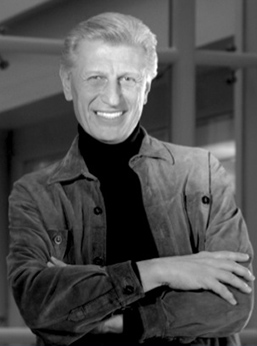
Lester Barnett defies categorization within the domains of medical advertising—creative, account service, strategic/media planner, and entrepreneur. His career displayed capabilities in all these agency disciplines. In a word, Barnett’s creative talents, marketing instincts, cultural interests, and his incomparable personality made him one of a kind. His work represents the power of idea generation in our business.
He began in Rx advertising as an art director, having attending Cooper Union. He worked at Sudler & Hennessey on a range of pharmaceutical accounts under the legendary Herb Lubalin, Ernie Smith, and Jim McFarland, learning the expansive creative philosophy of that agency. He then moved to Klemtner, where he met and became friendly with Bob Buechert, who was to transfer to Klemtner’s San Francisco office, which later became Barnum Communications. Buechert asked Barnett to join this new agency as creative director and Barnett made a fateful decision to move his family and career to the West Coast. Barnett was on the scene when Buechert and key employees like Barnett and Reg Bowes bought the agency and founded Vicom (now FCB HealthCare)—the agency that established a culture of medical advertising in San Francisco.
Those who know him mention Barnett’s career, but tend to concentrate on his style as a creative director and strategic marketer. “His personality,” says, Tom Domanico, chairman of FCB HealthCare, “was full of fun and energy. It was from that perspective…when you are having a good time, the work is better.”
John Loden, a former CEO at FCB, agrees on the work environment Barnett created: “Part and parcel is having fun while doing it. Lester was a big believer in enjoying himself and enjoying what he did. Even though he drove some people to distraction at times, it was always a tremendous amount of fun to have him around and to work with him.”
Barnett was a stimulating but demanding leader. Like so many creative directors, he pushed his staff for improvement right up to the deadline. Steve Gold, now a principal at Giant Creative, tells how his colleagues chided Barnett on his last-minute second thoughts: “[When he retired] one of his gifts that everyone got together on was a watch. On the watch it was only eleven o’clock…to represent Lester always coming in at the eleventh hour…at the worst possible time and challenging the work.”
This insistence by Barnett on getting the best is described by Pete Segal, now chief creative officer at Torre Lazur: “People liked Lester stretching them like rubber bands and also didn’t like stretching them like rubber bands. Sometimes from that dichotomy, from the pull, came great stuff…[he] was bored with anything less than ‘spectacular.’ I think mediocrity is not known to him. Not because it’s insulting, but because it’s simply boring.”
This intolerance with mediocrity was seen in the campaigns he supervised. Says Loden, “Lester had a disdain for the expected. He always wanted something that was a little bit outrageous…[but] not for the sake of being outrageous. Outstanding creative is strategically relevant and executionally unexpected. Lester understood that second part very well.”
The pairing of Barnett with a strong-minded, marketing innovator like Reg Bowes at Vicom proved extremely productive. At first, the two were at odds because Barnett objected to Bowes’ involvement with the creative work.
“They banged heads,” says Domanico, “because Lester didn’t buy into it right away. But over time, he saw the value in what Reg was bringing to the party.”
Segal says, “Reg is an original. Lester is an original. Two originals together create heat and light. They thrived on each other’s light and brilliance. It was extraordinary!”
The marketing programs that Vicom created were eye-openers for the industry. The agency helped Syntex build Naprosyn into a $1 billion brand, and this attracted attention from Merck, who assigned Vicom the failing muscle relaxant Flexaril as a test. With Bowes’ marketing insights from behavioral science and Barnett’s intrusive creative work, the brand experienced remarkable growth. Merck followed with other assignments on major brands: Vasotec, Zocor, and Fosamax.
Barnett’s attitudes and methods left an impact on those he worked with, but his legacy is in his ability to infuse a product’s promotion with a strategic personality. He used his art and cultural background to express product positioning.
Domanico says this: “He made the art a marketing tool…style…image…tone. He brought it to life on the page, where it spoke for itself beyond what the words said. The art spoke…to the strategic need.”
“Vasotec had to look like a quality product,” Bowes adds. “It needed some kind of housekeeping seal of approval…to say this product is a winner in its class. [Lester designed the Vasotec medal] and he found this wonderful green…the ‘upcoming color for that year’ that became the Vasotec theme along with the medallion.”
Loden comments on Barnett being a strategic thinker: “He had the ability to express strategic ideas in non-traditional ways. Fifteen years ago, he was talking about the need to keep Naprosyn a perpetual teenager. Now, what he was referring to is lifecycle management. Constantly coming back with new advertising, new line extensions, new clinical findings…It was being different to make a point, maybe more profoundly than other people could do it.”
Lester retired in 1996. He always has been a world traveler and continues his global adventures. He consults for industry, probably keeping ahead of the field with his eleventh hour watch.